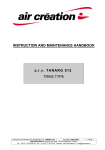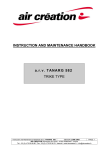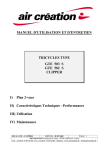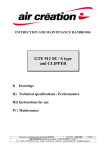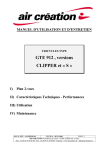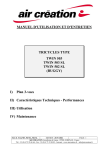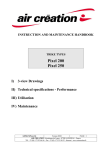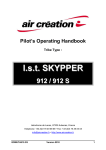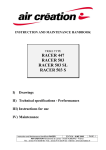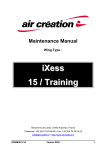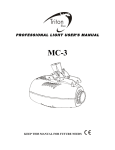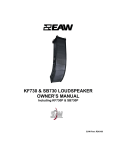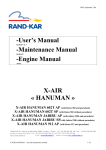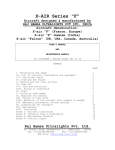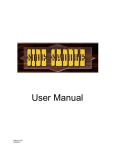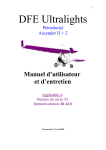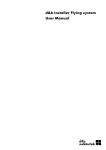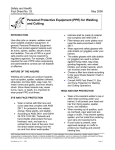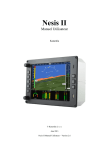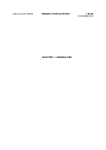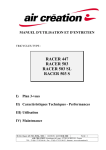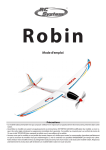Download INSTRUCTION AND MAINTENANCE HANDBOOK TRIKES TYPE
Transcript
INSTRUCTION AND MAINTENANCE HANDBOOK TRIKES TYPE TWIN 503 TWIN 503 SL TWIN 582 SL (BUGGY) I) Drawings II) Technical specifications - Performances III) Instructions for use IV) Maintenance PAGE : 1 Instruction and Maintenance Handbook Twin 503, 503 SL, 582 SL EDITION : JUNE 2002 AIR CREATION Aérodrome de Lanas - 07200 AUBENAS - France Tél. : 33 (0) 4 75 93 66 66 - Fax : 33 (0) 4 75 35 04 03 - Internet : www.aircreation.fr – [email protected] I) Drawings PAGE : 2 Instruction and Maintenance Handbook Twin 503, 503 SL, 582 SL EDITION : JUNE 2002 AIR CREATION Aérodrome de Lanas - 07200 AUBENAS - France Tél. : 33 (0) 4 75 93 66 66 - Fax : 33 (0) 4 75 35 04 03 - Internet : www.aircreation.fr – [email protected] II) Technical Specifications - Performances TWIN 503 (BUGGY) TWIN 503 SL (BUGGY) TWIN 582 SL (BUGGY) 105 kg 113 kg (125 kg) 120 kg (132 kg) Ultimate load factors at max weight + 6g -3g +6g -3g +6g -3g Limit load factor + 4g -2g + 4g - 2g + 4g - 2g Fuel tank Capacity 38 liters 38 liters 38 liters Rotax 503 Rotax 503 S Rotax 582 S 52 CV 52 CV 64 CV 6800 rpm 6800 rpm 6500 rpm Mechanical Mechanical Mechanical 1/ 2.58 1/ 3.47 1/ 3.47 2650 rpm 2000 rpm 2000 rpm 80 dB 76 dB 72 dB 81,3 dB 76 dB 72 dB Height from ground H 62 m 60 m 75 m Minimum height from ground for a noise inferior to 65 dB at maximum power 341 m 190 m 160 m Empty weight (Standard) Engine Max. Power Max. Rpm Reduction Drive Ratio Max. Propeller rpm Measured noise level Lm at max. wt - max. rpm Noise level corrected Lr *: Without options (see the list page 9 ) From the values shown above the on-the-ground loudness perception value Lh for aircraft flying at height h at maximum weight and rpm may be calculated using the formula: Lh = Lr - 22 log h H PAGE : 3 Instruction and Maintenance Handbook Twin 503, 503 SL, 582 SL EDITION : JUNE 2002 AIR CREATION Aérodrome de Lanas - 07200 AUBENAS - France Tél. : 33 (0) 4 75 93 66 66 - Fax : 33 (0) 4 75 35 04 03 - Internet : www.aircreation.fr – [email protected] III) Instruction for use a) Adaptation of wings and trikes The TWIN trikes can only be fitted to the FUN QC, XP, MILD, KISS and iXess twoseater wings manufactured by AIR CREATION. The high position of the propeller only allows assembly of short keel wings. Therefore, it is not possible to fit the following AIR CREATION wings: PLUS, QUARTZ, SX and FUN manufactured before March 1997. If the wing to be fitted was not supplied with the trike when purchased (different make or second-hand), check all parameters (height, displacement of the control bar, propeller clearance with keel ends) and make sure that there are at least 10 cm clear between the propeller and the wing structure, when all possible angles of attack are ground tested. b) Rigging/ Unrigging • • • • • • • • • • • • • Lift the wing, rest it on the nose and into the wind. Wheel the trike behind the wing, line it up with the keel, pull the upper beam down and take the front tube out. Raise the upper beam, push the hang point into the hang bracket, position the Ø10 hang bolt, install the butterfly nut and the locknut, tilt back the lever in order to tighten the plates and secure with split ring. Slip the back-up fastening cable through the belt loop at the king post, running it once around it. Slip it through the belt loop again and fasten it to the trike beam. The back-up fastening cable should be run under the tensioning cables. This operation secures the trike to the wing, also securing the wing cross-bar tensioning system. Place the propeller so that no blade stands in front of the keel axis. Raise the wing nose into a horizontal position. Attach the front strut between the aluminum flanges at the top of the upper beam using the bolt and the butterfly nut. Pick up the 'A' frame tubes, take hold of the control bar and lift the wing while preventing the trike from falling backwards. The front strut can be fitted into its locating position when the wing is lifted high enough. When rigging solo, rotate the instrument console, sit down on the trike beam facing the 'A' frame, take hold of the control bar, place it on your knees, raise the wing and fit the front strut as indicated. Install the upper beam safety bolt on the engine support using the butterfly nut, tilt the lever back in order to tighten the plates, slip the split ring in the hole of the bolt. Install the bolt connecting the front tube with the lower beam; screw the butterfly nut, secure with split ring.... Install the foam seat using the Velcro tabs. The front part of the rear bucket seat must be rolled around the frame seat, in front of the seat supporting strap, and then fixed with Velcro under this middle strap. Slip the Velcro between the seat frame and the different wires. Set into place the windshield of the panel by using the ¼ turn bolts. To disassemble reverse the assembly operations. Tilt the back of seat / container forward to the single-seater position before lowering the wing. PAGE : 4 Instruction and Maintenance Handbook Twin 503, 503 SL, 582 SL EDITION : JUNE 2002 AIR CREATION Aérodrome de Lanas - 07200 AUBENAS - France Tél. : 33 (0) 4 75 93 66 66 - Fax : 33 (0) 4 75 35 04 03 - Internet : www.aircreation.fr – [email protected] c) Preflight checks • • • • • Check the wing as indicated in its operating manual. Check the trike-to-wing attachments and all back-up devices. Check the front strut attachments to the trike upper and lower beams. Check the safety bolt on the upper beam-to-engine support attachment. Check propeller, exhaust and exhaust spring fasteners, air filter and rubber shocks mounts condition. • Check fuel filter, fuel primer bulb, fuel tank valve, and fuel hose condition. • Check coolant level in the expansion tank, water hose integrity, ensure that the radiator grill is free of debris, and check the radiator mount for water-cooled engine. • Make sure the sidebags, if installed, and the back of seat are closed. d) Trike and engine operation − Foot Throttle The power of the engine increases when pushing the top of the right pedal forward and decreases once you release the pressure on it. − Hand throttle Pushing the throttle lever forward increases power and pulling it back reduces power. − Ground steering The steering bar operates the front wheel direction. Push on the right side with your heel : the aircraft will turn to the left, and vice versa. − Brake Push the left pedal forward to operate the brake upon the front wheel. − Ignition switch Down : ON Up : OFF − Fuel cock The fuel valve is open when the lever is set horizontally in comparison with the ground, in the direction of the fuel flowing. The fuel valve is closed when the lever is pointing vertically, 90° from the hose axes. − Starting (manual engine start) • • • • Fill the tank with a mixture of premium petrol (GB), gas(oline) (U.S.) and (50 :1 mixture ratio) 2% synthetic oil (Recommended oil - CASTROL TTS). Open the fuel valve. Use the primer bulb on the fuel hose to prime the engine. Use the choke when the engine is cold. Place the throttle lever and foot pedal in the "idle" position. PAGE : 5 Instruction and Maintenance Handbook Twin 503, 503 SL, 582 SL EDITION : JUNE 2002 AIR CREATION Aérodrome de Lanas - 07200 AUBENAS - France Tél. : 33 (0) 4 75 93 66 66 - Fax : 33 (0) 4 75 35 04 03 - Internet : www.aircreation.fr – [email protected] Warning : The only safe way to state whether the engine is in the idle position is to listen for the typical sound of the throttle valve closing. Move the throttle lever back and forth to idle position to check. Do not start the engine until you have heard this sound: the control cable may need adjustment or may have jammed. Both are dangerous and a complete loss of control of the aircraft may result when starting. • • • Select the parking brake with the rack sets on the pedal. Set the ignition switch to "ON" with the interrupter located behind the hand throttle. Ensure that no one is standing close to the propeller and in a loud voice : "Clear prop" then pull the starter rope. • Turn the choke down when the engine has been running for a few seconds. The high reduction ratio of the 582 SL engine and the inertia of the propeller require a firm, powerful pull on the starter cord. Starting may be facilitated by 2 or 3 injections with the primer mounted on the engine support. • For engines equipped with a twin ignition system, check, after the engine has come up to working temperature, test that the two ignitions work independently by reversing the contactor set in front of the switch breaker box (Central position = ignition 1 + ignition 2), under the hand throttle. After the test, set the switch back to the central position 1+2. WARNING: For liquid cooling engine fitted out with a radiator under the lower beam of the trike, avoid a long-continued ground-run of the engine to prevent overheating due to lack of airflow wind particularly if the outdoor temperature is high. ONBOARD FEATURES − Inboard settling WARNING : an accident may occur while getting on board if the hand throttle lever is involuntarily moved forward. To eliminate this possibility, we recommend to get on board by the left handside of the trike and to be careful not to bump into the hand throttle on the right handside of the trike. • The positions of the front fork and the passenger foot-rest are adjustable for every one's comfort. Two holes situated on the lower beam of the trike allow for an adjustment of the fork and the pedals. For the passenger foot-rest, install the tube by positioning it above or under the lower beam. For dual control use, each modification in positioning the fork also involves changing the length of the dual control link tube operation in the appropriate holes set at the ends. • For a single-seater use, the movable luggage bag can be placed instead of the passenger foam seat, held by straps and Velcro fastenings. This bag is also usable as a back seat for the pilot, with the incorporated cardboard and rib. The load of the luggage bag set at the passenger place is limited to 25 kg (55 lbs.). It can be folded against the upper beam to be used as a back of seat for the passenger during two-seater flight. • Step on the non-skid part of the lower beam in front of the seat frame to embark on the rear seat; do not use the dual control footrest. • 4.5 lbs (2 kg) of varied tools can be placed in the pocket situated under the seat. The side bags have a carrying capacity of 11 lbs each (i.e. 5 kg each, material and luggage). PAGE : 6 Instruction and Maintenance Handbook Twin 503, 503 SL, 582 SL EDITION : JUNE 2002 AIR CREATION Aérodrome de Lanas - 07200 AUBENAS - France Tél. : 33 (0) 4 75 93 66 66 - Fax : 33 (0) 4 75 35 04 03 - Internet : www.aircreation.fr – [email protected] − Prior to take-off • Make sure the fuel valve is open. • Fasten and check seat belts engagement. WARNING: Safety belts should be placed at hip level and tightened correctly. The strap loops under the seats are positioned to ensure correct safety belt positioning. Never remove safety belts from the strap loops under the seats: Safety belts fastened at abdominal level may cause internal injury in the event of violent shock. • When aircraft is equipped with shoulder's strap, pull the buckle to release the winding system and fix it on the locating lug provided for this purpose, on the belt's side. • Check ignition switch by rapidly switching OFF and then ON with engine operating. • Check that the switch selector is on the central position 1+2. • Check that the control bar moves freely in roll and pitch axis. • Release the parking brake by a short pression of the brake pedal. − Take-off Use progressively full throttle when carrying a passenger. Throttle back slightly after having climbed 300 ft (100 m) to reduce engine wear. When flying solo, 3/4 throttle will suffice for take-off and climbing. Only use full power under critical conditions (short take-off runs, obstacles, high-altitude flight). In that case never reduce or cut the engine below the 300 ft (100 m) altitude to avoid dynamic stalling. For safety reasons, use the throttle lever rather than the foot pedal at take-off on rough terrain. Never take-off with less than 2.5 gallons petrol (10 l). The recommended speed for initial climb is indicated in the wing’s manual. − Cruising Keep the aircraft level with the throttle between 1/4 and full depending on given airspeed. Avoid repeated and sudden power climbs and idle dives to prevent sudden engine temperature changes, which could damage the engine by thermal shock. Fuel tank contents are easy to check as the tank is translucent and one can easily see it from both pilot and passenger seats. Landing shall be considered before tank contents has reduced to 1.5 gallons (5 liters). This allows approximately 30 minutes reserve of flight at low cruising speed. (This level corresponds to the upper part of the metallic tank bracket). − Landing The landing approach is best executed using the foot throttle pedal and both hands on the control bar. At maximum load, keep the throttle at 1/4 of full power when on final to facilitate flare-out. Throttle back when the wheels touch the ground. − Parking • Place the aircraft across the wind and place the extremity of the half-wing in the wind on the ground. • Stop the engine with the ignition switch. • Block the parking brake with the rack on the right side of the throttle. • Block the control bar on the front strut of the trike using a Velcro. • Leave the trike, pilot first, and always on the left side. PAGE : 7 Instruction and Maintenance Handbook Twin 503, 503 SL, 582 SL EDITION : JUNE 2002 AIR CREATION Aérodrome de Lanas - 07200 AUBENAS - France Tél. : 33 (0) 4 75 93 66 66 - Fax : 33 (0) 4 75 35 04 03 - Internet : www.aircreation.fr – [email protected] e) Emergency procedures − Power failure on take-off Should the power unit fail after take-off while still “at low height”, maintain aircraft control and safety approach speed, and land the aircraft straight ahead without attempting to turn back to the landing field. If time allows, set ignition switch off and fuel cock off − Power failure at altitude If the engine fails for any reason, prepare for and carry out the emergency landing procedures as follow: • Maintain aircraft control. • Immediately establish the best glide angle speed. • Check for suitable landing sites. Choose a number of preliminary options if time permits. • Turn ignition key off. • Close the fuel cock. • Check pilot and passenger seat-belts are tight and secure. • Check wind direction, either by natural indications such as smoke rising or by judging drift of aircraft over the ground, wind on the water. • Choose the most appropriate landing site. • Set up an approach as accurate as possible into wind. • Remember your aircraft cannot be heard. Check that no one is on the landing site. • Finalize your approach, deciding upon the best landing free of any obstacles. • Use a short landing technique with safety. • Evacuate the aircraft as quickly as possible, inviting the second occupant to do the same. − Restarting the engine in flight • Set ignition switch to ON. • Use the choke in the event of a prolonged stop. • Exert a quick pull with both hands on the starter rope. • Adjust throttle level then turn the choke off. WARNING: restarting the engine in flight may be tricky. Make absolutely sure you have a good margin of height and stay close to a landing field. − Engine fire Should an engine fire occur during flight: • Maintain aircraft control. • Maintain your flying speed. • Set fuel cock off. • Set ignition switch off. • Carry out the emergency landing procedures as above. PAGE : 8 Instruction and Maintenance Handbook Twin 503, 503 SL, 582 SL EDITION : JUNE 2002 AIR CREATION Aérodrome de Lanas - 07200 AUBENAS - France Tél. : 33 (0) 4 75 93 66 66 - Fax : 33 (0) 4 75 35 04 03 - Internet : www.aircreation.fr – [email protected] f) Empty weight The standard empty weight which is used to calculate the reference empty weight of the whole aircraft does not include the options stated hereafter. So, think of taking from the useful weight indicated on the third page of the user's manual of the wing, the weight of each option. g) Options 1) Three bladed propeller (on TWIN 503 only) This propeller made of composite materials attenuates the engine vibrations and allows a decrease in fuel consumption. It is adjustable from the ground. Set the recommended value of 13 ° is for current use. This propeller does not lead to any modifications in the aircraft behavior. One should never use it with a rotation speed over 2900 rpm. Its fitting does not change the empty weight of the trike. 2) Three points safety belt This option gives better occupant protection in case of major accidents or sudden shocks. Do not unbuckle your belt carelessly (keep the buckle in hand while unfastening) as the buckle could strike the propeller. The 3 points safety belt whole device reduces the useful load of the TWIN trike by 3.5 lbs (1.5 kg). 3) Parachute Trikes can be equipped with a pyrotechnic rocket parachute fixed under the engine. It can be integrated into the luggage compartment, if installed; a special cut allows its launching. To deploy the parachute, pull the red handle placed between the pilot's legs, on the seat frame. The parachute will allow the occupants and the aircraft to descent safely if a major problem occurs (collision, flight envelope exceeded). If altitude allows, switch the engine off before deploying parachute. If not, the engine will be stopped at the same time you pull the handle, due to the additional switch located on the handle fitting. Always inspect bridle connection points and activation cables before flying. WARNING: do not modify them. When rigging the wing, wires must be fixed with the link shackle. The parachute does not change the flight behavior of the microlight but its weight reduces the useful load by 22 lbs (10 kg). 4) Dual control for instruction This option allows for control of the ground steering and the engine power from the rear seat. For instructors, it allows full control from the rear seat of the aircraft. It reduces the useful load of the TWIN trikes by 2.2 lbs (1 kg). 5) Towing system The towing system reduces by 2.2 lbs (1 kg) the useful load of the GTE trikes. It allows streamers, advertising signs and hang glider towing. Pulling the lever, set in the left lower part of the frame seat, backward releases the towing cable. 6) Three instruments panel This case fastened onto the trike lower beam allows 3 engine control instruments fitting. TWIN models equipped as such have a useful load decreased by 1 lb (0.5 kg) PAGE : 9 Instruction and Maintenance Handbook Twin 503, 503 SL, 582 SL EDITION : JUNE 2002 AIR CREATION Aérodrome de Lanas - 07200 AUBENAS - France Tél. : 33 (0) 4 75 93 66 66 - Fax : 33 (0) 4 75 35 04 03 - Internet : www.aircreation.fr – [email protected] 7) Seven instruments console The console, which is mounted onto the lower trike keel is designed for 7 flight instruments of all types. Its folding support does not affect the wing mounting procedure described in section II b. TWIN useful load is reduced by 3.7 lbs (1.7 kg). 8) Rear wheel spats Rear wheel spats do not affect aircraft performance. They should be removed, emptied and cleaned after landing on muddy ground. Total kit weight is 3.7 lbs (1.7 kg). TWIN SL useful load is as much reduced when equipped with this option. 9) Side bags The two optional flight bags are installed on each side of the seat frame. Installation does not affect aircraft performance. Empty flight bag weight reduces TWIN useful load by 2.2 lbs (1kg). 10) The "BUGGY" integral fairing When equipped with integral fairing and wheel fairings with fins, the TWIN trike is named "BUGGY". These specific wheel fairings are essential for aircraft stability at high speed operations. The useful load is decreased by 27 lbs (12 kg) but the behavior remains the same as for aircrafts with no fairings. The procedure for rigging the wing changes with the Buggy trike. The windshield must be, at first, dismantled with a coin turning the nylon screws a 1/4 turn. Once the wing is fixed on the upper beam, lift it from the front of the trike which should be held by someone else or locked with a strap rolled around the front wheel to the ground. This will prevent the trike from moving backwards or falling over. Once the locking screws of the front tube and the safety screws of the upper beam are set on engine bracket, the windshield can be refitted. 11) Floats An option proposes an installation kit for a pair of floats. A specific manual describes the assembling. Only the FUN 18, MILD 16, KISS 450 and XP 17 wings fit for this particular use in respect to their low minimum speeds. We recommend to practice only on lakes with soft wind regarding the high position of the centre of gravity and problems of corroding in sea areas. The option weight, 50 kg (110 lbs.), reduces as much the useful load of the TWIN trikes and limits the possibilities of assembling other optional equipment in order to respect the authorized maximum weight. Instruction and Maintenance Handbook Twin 503, 503 SL, 582 SL EDITION : JUNE 2002 PAGE : 10 AIR CREATION Aérodrome de Lanas - 07200 AUBENAS - France Tél. : 33 (0) 4 75 93 66 66 - Fax : 33 (0) 4 75 35 04 03 - Internet : www.aircreation.fr – [email protected] h) Specific use / security instructions 1) Towing − The towing line must include a fuse gauged at 80 daN maximum in order to allow an automatic releasing in case of over-tensioning. − Release the towing line above a fully clear ground before landing. − Test systematically the releasing device of the trike before taking-off. − The ideal speed for towing streamers is 47 mph (75 km/h). In the case of a glider, the speed should be adapted to its performances. The emergency procedures stated in chapter III e) remain applicable; the towing must be launched above a fully clear field prior to landing. Characteristics, listed in the chart in chapter II c) of the concerned wing user’s manual, lessen due to the drag of towing and flying level requires a superior engine power. Minimum speed and stall speed remain unchanged. 2) Load carriage, survey material, data transmission, photography, video … − Install the loads to be carried on the passenger seat. The holding device has to support efforts up to 9 g forward, 3 g upward et 1,5 g laterally. − Limit the dimensions of the loads carried to avoid any contact, stress marks or blocking with the wing structure and particularly with the inferior longitudinal cables. − Mounting any kind of camera at the tip of the wing is possible up to a maximum weight of 2 kg (4.4 lbs) if you install a counterweight at the extremity of the opposite wing. The inertia of the wing on its roll axis will increase. − The emergency procedures stated in chapter III e) remain applicable. 3) Sky jumpers − The place is always the back seat, such as in normal tandem or "sidesaddle", body perpendicular to the trike axis. − Cut the engine before the preparatory step of the jump. You may use the wheel leg gear as a step. − A repetition on the ground is absolutely necessary before taking-off. − The emergency procedures stated in chapter III e) remain applicable. 4) Floats − Mounting of floats increases considerably the inertia of the trike in roll and yaw and reduces its performances due to the increase of the total drag. − The "taxiage" changes from the ground use by several aspects : ¾ The center of gravity is set higher and the leaning surface is not rigid, which involves a greater sensitiveness to the wind (risk of flipping over). "Pilot" the wings according to the indications of the flight manual, even more carefully than on the ground. ¾ The lack of brake requires a good management of the speed and you can fully stop only once the engine is off. ¾ The components used for the structure of the trike are not intended for a use on the sea owing to the risk of corroding and electrolytic stress due to the saltiness of this environment. ¾ The emergency procedures stated in chapter III e) remain applicable. Instruction and Maintenance Handbook Twin 503, 503 SL, 582 SL EDITION : JUNE 2002 PAGE : 11 AIR CREATION Aérodrome de Lanas - 07200 AUBENAS - France Tél. : 33 (0) 4 75 93 66 66 - Fax : 33 (0) 4 75 35 04 03 - Internet : www.aircreation.fr – [email protected] IV) Maintenance a) Transport Trikes should preferably be transported on light trailers. Transporting the trike on a roof rack or in a van requires disassembling the rear undercarriage. b) Storage The trike unit should be thoroughly checked and cleaned prior to storage. After cleaning, wipe all components with a clean lightly oiled cloth, while avoiding joints and rubberized parts. If the trike unit is to be stored for a long period (e.g.:2-3 months): • Place a well oiled cloth in the open end of the exhaust (leave it in evidence). • Cover the air inlet filter with several layers of protection to prevent condensation. • Drain the fuel tank. c) Running in Your trike's engine has been factory-tested but requires running-in. The engine should be run in on the ground as stated in the ROTAX instruction manual. Liquidcooled engines equipped with a radiator placed under the keel of the trike should be switched off when the water temperature reaches 185° F (85°C) to cool down. We recommend running in these engines in flight with no passengers, adhering as closely as possible to the ROTAX instructions. Except for take-off, avoid using full power for long periods during the first twentyfive hours. After this period change engine oil and filter and make a general check of the engine of first ten hours and tighten the bolts of the cylinder head. d) Pitch of the propeller The pitch of the ARPLAST propeller can be adjusted according to the wing used and the air density. A maximum ground speed of 5400 rpm is recommended for all the wings, except for the iXess which needs a maximum of 5200 rpm in order to prevent over-revving at full speed. Use the special tool and the Arplast manual to modify the pitch. e) Long storage It is recommended to dismantle the trike sail in case of a long storage for several months. Fold it properly, in respect with its manual, to loosen the tensions and to protect it from ultraviolet. For the trike, you only need to place a cover or a sheet upon it and to prepare the engine according to the Rotax user's manual. Reverse the operation to use it and make a single-seater local flight test before using the aircraft as usual. f) Maintenance For the maintenance of your engine, consult the Rotax manual. NEVER FLY USING AN UNBALANCED PROPELLER (due to a shock or any projection). Vibrations generated will damage the reduction gear and the trike frame. To check propeller balance: Remove the propeller and hang it, free to rotate (see your dealer), by the hub center. If unbalanced, it should be returned to the factory for repair. Frequently clean the radiator grill of the air inlet as well as the radiator cooling box (for liquid cooled engine), in order to avoid obstruction due to grass or debris. Instruction and Maintenance Handbook Twin 503, 503 SL, 582 SL EDITION : JUNE 2002 PAGE : 12 AIR CREATION Aérodrome de Lanas - 07200 AUBENAS - France Tél. : 33 (0) 4 75 93 66 66 - Fax : 33 (0) 4 75 35 04 03 - Internet : www.aircreation.fr – [email protected] Every 10 hours of flight time : • Change spark plugs. • Check trike, engine and propeller nuts. • Check the exhaust system, the rubber mounts and the springs. • Check air filter condition and attachments. • Check oil level in the reduction gear box, topping up when necessary. • Check fan belt tension for air-cooled engine. • Check liquid coolant, water pipes condition, make sure air intake of radiator is well clear for water-cooled engines. • Check fuel filter condition/ cleanliness, attachments and ensure there are no leaks on fuel hoses. • Check propeller condition. Every 50 hours of flight time : • Change the engine and exhaust mounting rubber mounts. • Change the 2 front wheel shock absorbers. • Change the manual starter cord. • Check the beams where the engine is mounted and around the swivel joint for cracks or movement. • Check seams on welded assemblies and mounting holes for movement (engine support, front forks, hooking frame point, beam swivel joint, radiator mount.). • Check rear shock absorber air pressure by exerting a lateral traction on the upper beam. Insufficient pressure will cause the trike suspension units to subside under load or lean excessively during turning on the ground or in cross-winds. Fill to 40 Bar using a special hand-pump where required (or see your dealer). • Every 25 landings maximum, check the length of the sliding tubes of the « shock absorber »set. The difference (sets at full extension) should not exceed 2mm. If not, you should arrange for an overhaul. Moreover the overhaul of the “shock absorber” set has to be made every 250 take-off or every 3 years of use. • Check condition and running of throttle and brake cables. • Clean the air filter. Every 100 flight hours : • Change gear box oil. • Change hoses, fuel filter and fuel primer bulb. • Decarbonize engine cylinders. • Change throttle and brake cables, all bolts involved in frequent mounting/demounting operations (hang point, front strut, etc.), engine and propeller mounting bolts. • Check tires, rims, wheel bearings front fork and wheel axles. • Check engine support, hang point, undercarriage struts and links, wheel shafts and seat seams. • Check upper and lower mounting connections of front tube. Remove the upper and lower Nylon bases and inspect the tube where it enters the hole for ovalization or cracks. Instruction and Maintenance Handbook Twin 503, 503 SL, 582 SL EDITION : JUNE 2002 PAGE : 13 AIR CREATION Aérodrome de Lanas - 07200 AUBENAS - France Tél. : 33 (0) 4 75 93 66 66 - Fax : 33 (0) 4 75 35 04 03 - Internet : www.aircreation.fr – [email protected] After any heavy landing : • Check the front fork, remove and inspect the fork pivot and wheel axis. • Check the seat frame and lower beam for distortion. Check seat seams. • Check the upper beam and the front strut, the swivel joint (movement, cracks), the engine support and the engine mounting rubber mounts. • Check the rear wheel assembly, loosening of assembly devices and shock absorber pressure. • The structure of the wing must be completely inspected in our premises or by an approved technical establishment after any heavy landing or even for slight damages. WARNING : Changing all NYLSTOP nuts after loosening is mandatory. Always secure such nuts using particular LOCTITE glue. Instruction and Maintenance Handbook Twin 503, 503 SL, 582 SL EDITION : JUNE 2002 PAGE : 14 AIR CREATION Aérodrome de Lanas - 07200 AUBENAS - France Tél. : 33 (0) 4 75 93 66 66 - Fax : 33 (0) 4 75 35 04 03 - Internet : www.aircreation.fr – [email protected] PERIODICAL OVERHAULS BOARD Serial number : Date Hours flown Company which has carried out the overhaul address and stamp Instruction and Maintenance Handbook Twin 503, 503 SL, 582 SL EDITION : JUNE 2002 PAGE : 15 AIR CREATION Aérodrome de Lanas - 07200 AUBENAS - France Tél. : 33 (0) 4 75 93 66 66 - Fax : 33 (0) 4 75 35 04 03 - Internet : www.aircreation.fr – [email protected] PERIODICAL OVERHAULS BOARD Serial number : Date Hours flown Company which has carried out the overhaul address and stamp Instruction and Maintenance Handbook Twin 503, 503 SL, 582 SL EDITION : JUNE 2002 PAGE : 16 AIR CREATION Aérodrome de Lanas - 07200 AUBENAS - France Tél. : 33 (0) 4 75 93 66 66 - Fax : 33 (0) 4 75 35 04 03 - Internet : www.aircreation.fr – [email protected] Notes Instruction and Maintenance Handbook Twin 503, 503 SL, 582 SL EDITION : JUNE 2002 PAGE : 17 AIR CREATION Aérodrome de Lanas - 07200 AUBENAS - France Tél. : 33 (0) 4 75 93 66 66 - Fax : 33 (0) 4 75 35 04 03 - Internet : www.aircreation.fr – [email protected] TRIKE - QUALITY FORM Anxious to ensure the perfection of our products, we have set a sequence of controls covering all the steps of production. We are working continuously on their improvement and we are in need of your help. Please return this reply form accurately filled if you find any mistake or problem concerning your trike, which could affect its quality or finish, even if it is a minor one. Your name, address and telephone number : Type : Delivery date : Trike number : Engine serial number : Distributor : Hours flown : Problems noticed : (explanations and / or drawing) ¼ PAGE : 2 Instruction and Maintenance Handbook Twin 503, 503 SL, 582 SL EDITION : JUNE 2002 AIR CREATION Aérodrome de Lanas - 07200 AUBENAS - France Tél. : 33 (0) 4 75 93 66 66 - Fax : 33 (0) 4 75 35 04 03 - Internet : www.aircreation.fr – [email protected]


















